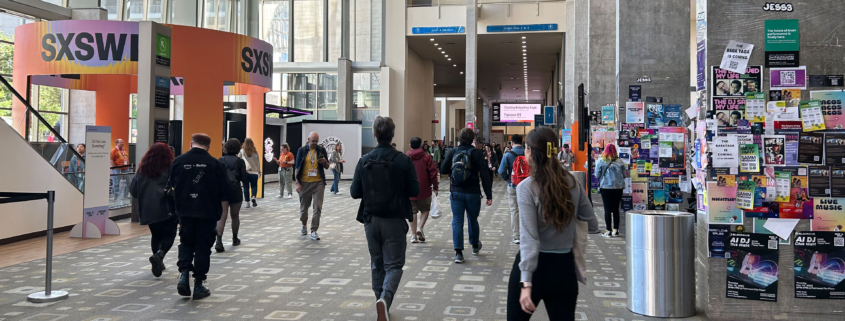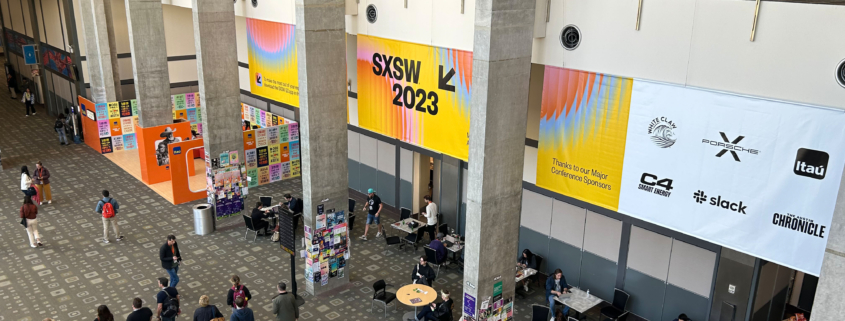Last recap daily for SXSW 2023 with a couple of great sessions on marketing and pretty pictures from space! Usually, Tuesdays at SXSW see the attendance for the interactive tracks going down, with the music tracks and showcases ramping up – not so this year, every session we attended was completely packed.
I think SXSW will be very, very happy with the attendance this year, after the dramatic decrease of visitors in 2022. At times it felt like the crazy days of 2018 and 2019, it casts a positive outlook on the coming years. More attendees mean more attention from high profile speakers, visitors and brands what keeps the conference as relevant as it is. I think that’s worth the queue times.
The future of marketing is all about convergence
The day started with a session full of high-profile marketeers on the biggest stage. Conny Braams from Unilever, Jeremi Gorman from Netflix and Tim Mapes from Delta Airlines discussed current trends and developments in marketing strategies for the FCMG, entertainment and service industry.
I already mentioned in previous recaps this year that convergence was a big meta trend in many fields, with the most interesting things happening at the intersections of different areas. It’s the same in marketing. Conny Braams stated that the way forward for not only FMCG brands was the increased integration between branding, performance and sales. Tackling the challenge of combining brand building while also driving conversion at the same time was the #1 task for marketers and agencies. Unilever’s internal structure already reflects this with a combination of previously separated teams now all working together for the common goal, going as far as adjusting product design for this new reality.
Tim Mapes from Delta even went one step further – for him, every Delta employee is a brand ambassador and potential brand touchpoint. For Delta, generating first party data through their frequent flyer program with its corresponding app is one central pillar of this strategy – the other one: making the data available to customer facing roles, so consumer facing staff can use it to deliver more authentic and informed interactions with each individual traveller.
Another big topic of discussion was the rise of retail media: for Unilever retail media is a perfect tool to control the elusive last mile at the store where crucial purchase decisions actually happen – that was previously controlled exclusively by retailers. Digital retail and retail media let’s the brands take much more control here – assuming the interactions with consumers are not purely transactional, but creative and entertaining and brands get access to the data generated. Again, convergence is key for future marketing.
The five laws of brand science
My second session of the day was a highly interactive and entertaining talk by Ethan Decker from Applied Brand Science. In his presentation, Decker went over five laws of brand science, that marketers should be aware of – backed by years of research and data.
He offered an interesting way on how marketers laud customer loyalty as the pinnacle of marketing – despite the fact, that most consumers, for most categories, will buy a repertoire of brands and the more someone buys from a category, the bigger that repertoire gets. For many verticals, it also makes little sense to chase deep consumer connection, because people simply don’t care what their e.g. toilet paper brand of choice does on social media or what their brand purpose might be.
Decker stated that shoppers are “mental misers”: the average consumer simply is too lazy to deal with hard and complicated questions when making a purchase decision and suggested that marketers should focus on the easy questions shoppers are asking themselves when buying from a category.
Additionally, when it comes to light / medium / heavy buyers, the curve for almost all brands looks like a banana. High amount of single time / low frequency buyers, very few medium and heavy buyers – negative binomial distribution, or simply: the good old long tail. For growth, market penetration is 5 to 15 times more important than buying frequency according to a study conducted by Bain & Company, so marketing should focus on that lever first.
Advanced Space Photography
One thing to love SXSW for: they don’t shy away from giving keynote spots on the biggest stage to topics most of us know very little about. In this case: NASA and an all-female panel of astrophysicists sharing insights on the first few months of operating the James Webb Space Telescope. In addition to showing some of the mind-blowing pictures taken by the JWST in recent months, the panel discussed the massive effort of international collaboration between 14 countries to make this happen, the scientific breakthroughs this already led to and their deep-rooted love for discovery and human curiosity.
Advertising’s guilty secret
SXSW is a great spot for inspiration and creating new food for thought from various disciplines. But at the end of the day we are still advertisers, so it’s always refreshing to see sessions that speak the truth about our day-to-day work. Today, Welsh advertising expert and CEO of Creature London, Dan Cullen-Shute together with Ivonne Kinder from Avocados from Mexico, gave us exactly that: A critical look at what the advertising business has morphed into, at least at award shows. Looking at the recent Cannes Lion Grand Prix winners, 90% of them were purpose-driven, which of course is a honorable messaging and there’s nothing wrong with that, but often these great award ideas either never reach a broader audience outside or aren’t linked to an equally good media strategy.
Dan spoke many truths today: Advertising is brilliant. We can make things that have genuine cultural touchpoints, boost the economy in needed areas, spark happiness and connect communities. The cherry on top: There are not many other jobs where the level of seriousness and ridiculousness can be the same. It should always be our mission to leave the industry better than we found it, in one way or another, so let’s get back to that: Make people laugh again, create epic things, even be totally ridiculous if appropriate. Get back to the heart of what we do and love – creating awesome stuff that makes brands grow and touches the hearts of our audiences.
Random observations from Day 5:
- Props to the SXSW organizers for enabling encore sessions for popular talks – and double props to the speakers of being just as engaging in round 2.
- It’s surprisingly hard to find good filming locations at SXSW – unless you want to give your video interview on the latest trends in tech & marketing strong 80s Dallas vibes – as the main color scheme of every conference hotel is beige, even the one built in 2017.
- I don’t know if it’s the overall inflation, the fact that Austin has been attracting thousands of highly paid tech workers in recent years or simply SXSW price gauging – but getting food is making your credit card bleed.




